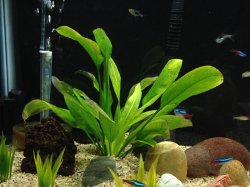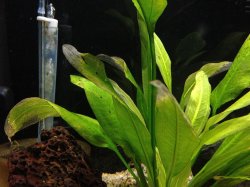My first live plant is getting browning/transparent tips on the larger leaves.
It's a Echinodorus bleheri (Amazon Sword). I'm attaching a couple pictures.
It's in a 30 Gallon tank. The only thing I know about the lights is that they are LED. I keep them on about 12 hours a day.
Earlier today, I noticed my Bristle Nose Pleco "sucking" on the leaves. I'm not sure if he's cleaning or snacking.
Does it need pruning? Fertilizer? Is this just normal plant aging. My guess is, no.
I've read that it is a fast growing plant, but I'm not seeing much evidence of that. Maybe it's the wrong plant for the substrate. I've been told that maybe a floating plant might be better for the fish I have. (Tetras, and most recently Rasboras)
Any advice would be appreciated.
Thanks.
Previous advice from a separate topic that was starting to stray from the original question:
It's a Echinodorus bleheri (Amazon Sword). I'm attaching a couple pictures.
It's in a 30 Gallon tank. The only thing I know about the lights is that they are LED. I keep them on about 12 hours a day.
Earlier today, I noticed my Bristle Nose Pleco "sucking" on the leaves. I'm not sure if he's cleaning or snacking.
Does it need pruning? Fertilizer? Is this just normal plant aging. My guess is, no.
I've read that it is a fast growing plant, but I'm not seeing much evidence of that. Maybe it's the wrong plant for the substrate. I've been told that maybe a floating plant might be better for the fish I have. (Tetras, and most recently Rasboras)
Any advice would be appreciated.
Thanks.
Previous advice from a separate topic that was starting to stray from the original question:
We can look into the plant issues if you provide data on the light (type, watts, spectrum, etc), and are you using any fertilizers or plant additives, and if yes, which and how much.
Floating plants are the easiest to maintain because they have the aerial advantage, meaning that the floating leaves are able to take up CO2 from the air which is about four times faster than from the water, and obviously there is an abundance of CO2 in the air but may not be in the water. Plus the closeness to the light means that is not usually an issue, though we still need to know the specs. A comprehensive liquid fertilizer may be required, but that is easy to handle.
The advantages of floating plants are that being fast-growing, they use a lot of nutrients which means a lot of water filtration occurring. They are almost ammonia sinks, they take up so much relatively speaking. But they also provide a cover, and all of these forest fish appreciate this as it is natural. Most forest fish occur in heavily-shaded waters, provided by overhanging terrestrial vegetation in most cases but floating plants fill this requirement nicely, and have the filtration benefit too. Water Sprite, Water Lettuce, and Frogbit are good floaters. I would personally avoid the smaller floating plants like duckweed and Salvinia, though the latter is a lovely little plant. Some stem plants grow very well left floating; pennywort is ideal for this, I use it in a couple of my Amazonian tanks.
Just as a comparison, I have a 29g (with these tank dimensions) as one of my 7 tanks in my fish room, and currently it holds around 60 fish. Now, they are all small, and all have identical requirements respecting water parameters, lighting, environment (aquascaping), water current, etc. And this is the crux of the matter...have completely compatible fish. As I mentioned previously, providing what the fish require will actually lessen their impact on the tank's biological system because they are not "fighting" issues. "Compatibility" involves fish behaviours of course, but it goes much farther than that.
Byron.




